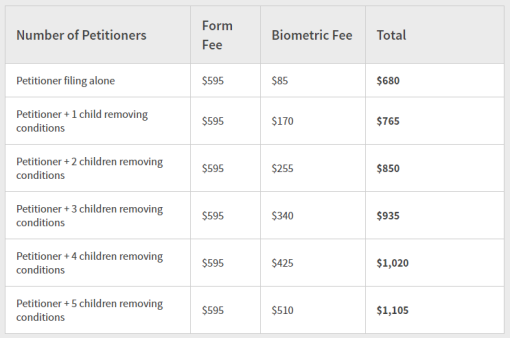Form I-751 is a crucial step in your immigration journey if you’ve obtained conditional permanent resident status through marriage to a U.S. citizen or permanent resident. This form allows you to apply to remove the conditions on your residence, paving the way for permanent residency.
What is Form I-751?
Form I-751, officially known as the “Petition to Remove Conditions on Residence,” is a form used by conditional permanent residents to request the removal of the conditions on their permanent resident status obtained through marriage to a U.S. citizen or lawful permanent resident.
When a foreign national marries a U.S. citizen or permanent resident and has been married for less than two years at the time of obtaining permanent resident status, they receive what is called a “conditional” green card. This conditional status is valid for two years.
To transition from conditional permanent resident status to unconditional permanent resident status, the couple must jointly file Form I-751 during the 90-day period immediately before the conditional residence expires. This joint petition aims to prove that the marriage was entered into in good faith and not for the purpose of evading U.S. immigration laws.
The primary purpose of Form I-751 is to provide evidence to USCIS that the marriage is genuine and ongoing. It requires submission of documentation, such as joint financial records, leases or mortgages showing joint ownership, birth certificates of any children born during the marriage, and affidavits from friends and family attesting to the authenticity of the relationship.
Upon approval of Form I-751, the conditions on the permanent resident status are removed, and the individual receives a regular, 10-year green card, granting them permanent resident status without conditions.
Who Needs to File Form I-751?
Form I-751, the Petition to Remove Conditions on Residence, needs to be filed by individuals who have obtained conditional permanent resident status through marriage to a U.S. citizen or lawful permanent resident.
Specifically, those who need to file Form I-751 include individuals who:
- Received a Conditional Green Card: If you were granted conditional permanent resident status based on marriage and your marriage was less than two years old at the time of obtaining your green card, you must file Form I-751.
- Are Still Married: You should file jointly with your spouse within the 90-day period immediately before your conditional green card expires. Filing jointly is the typical procedure, but there are exceptions for cases involving divorce, abuse, or extreme hardship.
- Are Dependent Children: In certain cases where the conditional permanent resident’s children also obtained conditional status at the same time, they might be included in the same I-751 petition.
When Should You File Form I-751?
Form I-751 should be filed during the 90-day window immediately before the expiration of your two-year conditional permanent resident status. It’s crucial to submit the form and all required documentation within this specific timeframe.
Here’s a breakdown of the timeline:
- 90-Day Filing Window: You should file Form I-751 jointly with your spouse during the 90 days before the expiration date of your conditional green card.
- Expiration of Conditional Green Card: Conditional permanent resident status is valid for two years. Before this status expires, it’s imperative to initiate the process of removing conditions on your residency by filing Form I-751.
- Filing Late or After Expiration: Failing to file Form I-751 within this 90-day period may lead to severe consequences, including the loss of lawful permanent resident status and potential removal from the United States.
Documents Required for Form I-751
Form I-751, the Petition to Remove Conditions on Residence, requires specific documents to support your application for the removal of the conditions on your permanent resident status obtained through marriage. Here’s a list of essential documents you’ll need to submit along with Form I-751:
- Copy of Conditional Green Card (Form I-551): Include a clear photocopy of both sides of your two-year conditional green card.
- Proof of a Bona Fide Marriage: Provide evidence that your marriage is legitimate and not solely for immigration purposes. This may include but is not limited to:
- Joint financial documents (bank statements, joint tax returns, insurance policies)
- Leases or mortgage documents showing joint ownership or residence
- Birth certificates of any children born into the marriage
- Affidavits from friends, family, or third parties attesting to the authenticity of your relationship
- Personal Documents Showing Continued Marital Relationship: Include documents that demonstrate an ongoing marital relationship beyond the wedding. This might consist of:
- Photos of you and your spouse together at various events or occasions
- Correspondence addressed to both of you at the same address
- Travel records showing vacations taken together
- Legal Documents: If there have been any legal issues or changes in your marital status (such as divorce or separation), include official documentation to clarify the situation.
- Additional Evidence: Any other documents that can substantiate the legitimacy of your marriage and your ongoing relationship. This could involve:
- Joint utility bills (electricity, water, gas)
- Correspondence between both spouses (emails, letters)
- Affidavits or statements from individuals who have knowledge of your relationship
- Form I-751 Fee Payment: Ensure that you include the required fee with your application, unless you qualify for a fee waiver.
Remember, it’s crucial to submit a comprehensive and well-organized package of evidence to support your case. Include a cover letter summarizing the contents of your submission to provide USCIS officers with a clear overview of your application.
Always check the latest USCIS guidelines or consult with an immigration attorney to ensure you have the most up-to-date and accurate information before submitting your Form I-751 and accompanying documents.
Where and How to Submit Form I-751
The submission process for Form I-751, the Petition to Remove Conditions on Residence, allows for both online and physical submission methods. As the process can be complex, we recommend getting assistance from immigration attorneys like us. Here’s a breakdown of how and where to submit the form:
Online Submission (E-Filing):
- USCIS Online Filing: Visit the USCIS website and navigate to the I-751 form page. Follow the instructions to create an account or log in if you already have one.
- Form Completion: Fill out the electronic form online, ensuring all necessary fields are completed accurately.
- Document Upload: Scan and upload the required supporting documents as specified by the USCIS guidelines.
- Payment: Pay the filing fee (around $595 + $85) or request a fee waiver if eligible.
- Review and Submit: Double-check all information, review the application thoroughly, and submit the form electronically.
- Confirmation: After submission, USCIS will provide a confirmation of receipt and further instructions or updates through your USCIS online account.
Physical Submission (Mail):
- Form Completion: Fill out the Form I-751 accurately and legibly using black ink or typing, following USCIS guidelines.
- Document Compilation: Organize all required supporting documents as specified by USCIS guidelines. Make copies of the originals to include with your application.
- Payment Method: Prepare a check or money order for the filing fee payable to “U.S. Department of Homeland Security.”
- Mail to the Appropriate USCIS Service Center: Choose the correct USCIS Service Center based on your state of residence. USCIS provides specific addresses for filing based on geographic location.
- Certified Mail or Courier Service: Use a reliable mailing service with tracking or delivery confirmation to ensure the package’s safe arrival.
- Receipt Confirmation: USCIS will send a receipt notice by mail to acknowledge the application’s acceptance and provide further instructions or updates.
I-751 Filing Fee
The filing fee for 1-751 is around $595 & you must also pay a $85 biometric services fee for each person applying to remove conditions on their residence on the same form. See the detailed fee table below.

Common Mistakes to Avoid when Filling Form I-751
Navigating Form I-751 requires attention to detail to prevent common errors that could delay or jeopardize your application. Here are key mistakes to avoid:
- Late Filing: Missing the 90-day window before your conditional residence expires can lead to serious consequences, including deportation. Ensure timely submission.
- Incomplete Forms: Failing to fill out every section accurately or leaving required fields blank can result in rejection or delays. Double-check all information before submission.
- Insufficient Evidence: Providing minimal or inadequate proof of a bona fide marriage can weaken your case. Include diverse documentation spanning the period of your marriage.
- Lack of Communication: If you’re filing jointly and your spouse is unwilling to participate, failing to explain the situation or not providing a detailed explanation can raise red flags.
- Ignoring Legal Changes: Not updating USCIS about changes in your marital status, such as divorce or separation, can complicate your case. Submit relevant legal documents promptly.
- Using Outdated Forms or Guidelines: Always use the most recent version of Form I-751 and follow the current USCIS guidelines to avoid discrepancies or rejections.
- Missing Deadline for Responses: If USCIS requests additional evidence or schedules an interview, failing to respond within the given timeframe can lead to denial.
- Lack of Organization: Submitting a disorganized package of documents without a cover letter or clear organization can make it difficult for USCIS officers to assess your case efficiently.
- Not Seeking Professional Help When Needed: Complex situations, legal issues, or uncertainties should prompt seeking guidance from an immigration attorney to ensure proper submission.
- Ignoring Requests for Additional Information: If USCIS requests more evidence or clarification, ignoring these requests instead of providing the required information can lead to denial.
Avoiding these common pitfalls requires careful attention to detail, timely action, and a thorough understanding of the requirements outlined by USCIS. Review your application meticulously before submission and seek professional guidance if needed to navigate this process effectively.
File Form I-751 with an Immigration Attorney

Seeking assistance from an immigration attorney for the Form I-751 process can be immensely beneficial, especially in complex cases or situations where you might face challenges. Here’s how an immigration attorney can help:
- Understanding Eligibility: An attorney can assess your eligibility for filing Form I-751 and provide guidance based on your specific circumstances.
- Navigating Complexities: If there are legal complexities or unique situations in your case (divorce, abuse, separation, etc.), an attorney can offer tailored advice and solutions.
- Accuracy and Completeness: Attorneys ensure all required forms are filled out accurately, and the supporting documentation meets USCIS standards.
- Avoiding Errors: They can help prevent common mistakes that might lead to delays or denials.
- Communication with USCIS: Attorneys can handle correspondence with USCIS on your behalf, responding to queries and providing additional evidence when required.
- Legal Representation: In case of interviews or hearings, an attorney can represent you, providing legal counsel and support.
- Addressing Challenges: If your application faces issues or complications, an attorney can strategize and navigate solutions to address these challenges effectively.
- Appeals and Rejections: In case of denial, they can assist with the appeals process.
- Confidence in Process: Having an experienced professional guide you through the process can provide reassurance and confidence that your application is being handled correctly.
What Happens After Submitting I-751
After you submit Form I-751 (Petition to Remove Conditions on Residence) to USCIS, the process involves several steps:
Receipt Notice: USCIS sends a receipt notice acknowledging the receipt of your application. This notice provides a unique case number, which you can use to track the status of your application.
Biometrics Appointment: In many cases, USCIS schedules a biometrics appointment for fingerprinting and photographing. This helps verify your identity and conduct background checks.
Request for Evidence (RFE): If USCIS requires additional documentation or information to support your application, they will issue a Request for Evidence. Respond promptly and thoroughly to this request.
Interview (if required): USCIS may schedule an interview to further assess the validity of your marriage and the legitimacy of your case. Both you and your spouse may need to attend.
Processing Time: USCIS processes applications in varying time frames, which can fluctuate based on workload and the complexity of your case. You can check USCIS processing times on their website.
Decision: After completing the necessary steps (biometrics, additional evidence submission, interview if applicable), USCIS will make a decision on your case. They may approve, deny, or issue a Request for Further Evidence (RFE) based on the information provided.
Approval or Conditional Green Card Extension: If approved, USCIS will send you a new green card without conditions, valid for ten years. In some cases, USCIS might grant a temporary extension of your conditional green card while processing your case.
Denial: If your application is denied, USCIS will provide reasons for the denial. You might have the option to appeal or, in some cases, refile your application.
Permanent Resident Status: Upon approval, your conditional status is removed, and you become a permanent resident without conditions. You can enjoy the rights and benefits of a permanent resident.
Continued Communication: Throughout the process, USCIS might request further information or documentation. Ensure you respond promptly and accurately to any such requests.
Frequently Asked Questions about Form I-751
How long does it take to process Form I-751?
Processing times for Form I-751 can vary based on workload, location, and individual circumstances. Generally, it can take several months to over a year for USCIS to process the petition. Checking USCIS processing times regularly can provide an estimate for your specific situation.
Are there interview requirements for Form I-751?
While not every case requires an interview, USCIS may schedule one to further evaluate the legitimacy of the marriage. Both you and your spouse may need to attend the interview and provide evidence supporting the authenticity of the marriage.
What happens if I miss the 90-day filing window before my conditional green card expires?
Missing the 90-day filing window can have serious consequences. Failing to file Form I-751 on time may result in the termination of your lawful permanent resident status. However, if you have a valid reason for filing late (such as extreme circumstances or unavoidable situations), you can submit a late filing along with a detailed explanation and evidence supporting your case.
Can I travel outside the United States while my Form I-751 is pending?
It’s generally advisable to avoid international travel while your Form I-751 is pending to ensure that you are available for any USCIS requests or interviews. If you must travel, ensure you have proper documentation, such as the Form I-551 stamp on your passport or a valid, unexpired green card to re-enter the United States.
What should I do if my Form I-751 application is denied?
If your Form I-751 application is denied, you will receive a written notice explaining the reasons for the denial. You might have the option to appeal the decision or file a motion to reopen or reconsider the case. Consulting with an immigration attorney is advisable to understand your options and determine the best course of action based on your specific circumstances.
Get Help with Filing Form I-751
Filing Form I-751 is a critical step towards securing permanent residency in the United States. By submitting accurate and comprehensive documentation that proves the legitimacy of your marriage, you increase the chances of a successful application. Stay informed, follow the guidelines diligently, and seek professional help if needed to navigate this process smoothly.
At Rebecca Black Immigration, PA, we understand the complexities that come with immigration processes like Form I-751. Our team comprises experienced professionals dedicated to supporting you through every step of the journey. We’re committed to making your immigration journey as smooth and stress-free as possible. Contact us today to explore how we can support you through your Form I-751 process and beyond.







